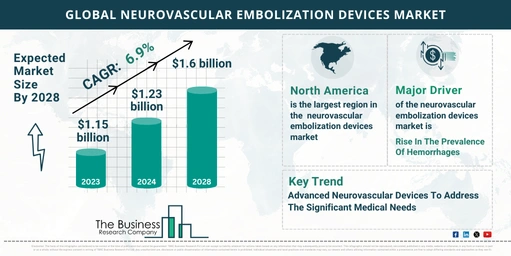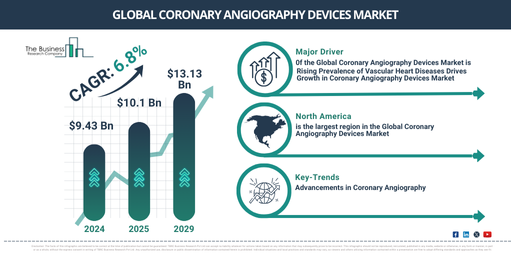How Is The Neurovascular Embolization Devices Market Expected To Grow Through 2024-2033
The Business Research Company’s global market reports are now updated with the latest market sizing information for the year 2024 and forecasted to 2033
According to The Business Research Company’s Neurovascular Embolization Devices Global Market Report 2024, the neurovascular embolization devices market is expected to show promising growth in the forecast period.
The neurovascular embolization devices market has experienced significant growth in recent years and is expected to continue expanding in the coming years. This blog will explore key drivers, trends, and developments in this market, along with a focus on rising hemorrhages, advancements in technology, and strategic acquisitions.
Strong Market Growth in Recent Years
- Market Size in 2023: The neurovascular embolization devices market reached a size of $1.15 billion in 2023.
- Growth Rate: The market is projected to grow at a compound annual growth rate (CAGR) of 6.7%, reaching $1.23 billion by 2024.
- Drivers: Key factors contributing to this growth include the increased prevalence of neurovascular disorders, a rising geriatric population, and the demand for minimally invasive procedures. Improved healthcare infrastructure and increased healthcare expenditure have also played a significant role in driving market expansion.
Projected Future Growth and Emerging Trends
- Future Market Size: The market is expected to grow to $1.60 billion by 2028, with a slightly higher CAGR of 6.9%.
- Emerging Trends:
- Personalized Treatment: The market is seeing a shift towards personalized treatment approaches, offering more targeted and effective solutions for patients.
- Artificial Intelligence: The integration of AI in treatment planning is becoming increasingly prevalent, improving precision and outcomes.
- Next-Generation Materials: The development of next-generation embolic materials is a significant trend, enhancing the safety and effectiveness of treatments.
- Outpatient Procedures: There is a growing trend towards outpatient and ambulatory procedures, making treatments more accessible and reducing hospital stays.
- Innovative Techniques: Continuous innovation in embolization techniques is expected to drive further market growth.
View More On The Neurovascular Embolization Devices Market Report 2024 – https://www.thebusinessresearchcompany.com/report/neurovascular-embolization-devices-global-market-report
Rising Hemorrhages Drive Market Expansion
- Hemorrhage Prevalence: The rising prevalence of hemorrhages is a major factor propelling the neurovascular embolization devices market. Hemorrhages, which involve uncontrolled bleeding either internally or externally, are becoming more common due to aging populations, increased hypertension, and the use of anticoagulant medications.
- Neurovascular Devices: These devices are crucial in treating hemorrhagic strokes by obstructing abnormal blood vessels, reducing bleeding, and preventing further brain damage.
- Significant Data: A study from King’s College London predicts that cases and deaths from intracerebral hemorrhage (ICH) will increase by 59.4% among people aged 70 to 95 in the UK by 2050. This highlights the growing need for neurovascular embolization devices in managing such conditions.
Technological Advancements Lead to Competitive Edge
- Advanced Technology: Companies are focusing on developing products with advanced features like Shield Technology, which enhances the efficacy and safety of neurovascular devices.
- Example: Medtronic PLC launched the Pipeline Vantage with Shield Technology in 2022, a fourth-generation flow diverter designed to improve endovascular procedures. This device promotes cell growth in the blood vessel’s inner lining, offering a minimally invasive treatment option for aneurysms and reducing the risk of rupture.
Strategic Acquisitions Bolster Market Position
- Stryker Corporation’s Acquisition: In May 2023, Stryker Corporation acquired Cerus Endovascular Ltd for $530 million to enhance its intracranial aneurysm treatment portfolio. This acquisition enables Stryker to offer innovative devices like the contour neurovascular system and the neqstent coil-assisted flow diverter.
- Impact: Such strategic acquisitions strengthen companies’ positions in the market, allowing them to expand their product offerings and better meet the growing demand for neurovascular treatments.
Market Segmentation and Regional Insights
- Product Segmentation: The neurovascular embolization devices market is segmented by product types, including Embolization Coils, Liquid Embolic Systems, Flow Diversion Stents, Aneurysm Clips, and others.
- Treatment and Indication: Treatments are segmented into Ischemic Stroke Solutions and Hemorrhagic Stroke Solutions, with indications including Brain Aneurysms, Arteriovenous Malformation, and others.
- End Users: Hospitals and Ambulatory Surgical Centers are the primary end users of these devices.
- Regional Growth: North America was the largest region in the market in 2023, while the Asia-Pacific region is expected to be the fastest-growing market during the forecast period.
In conclusion, the neurovascular embolization devices market is poised for continued growth, driven by rising neurovascular disorders, technological advancements, and strategic industry moves. As the market evolves, personalized treatment approaches, AI integration, and innovative materials will play a crucial role in shaping the future of neurovascular care.
Request A Sample Of The Global Neurovascular Embolization Devices Market Report 2024:
https://www.thebusinessresearchcompany.com/sample_request?id=15871&type=smp



